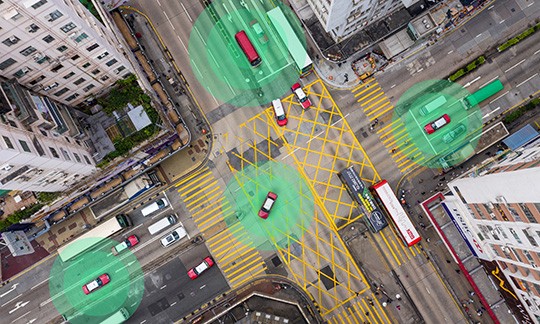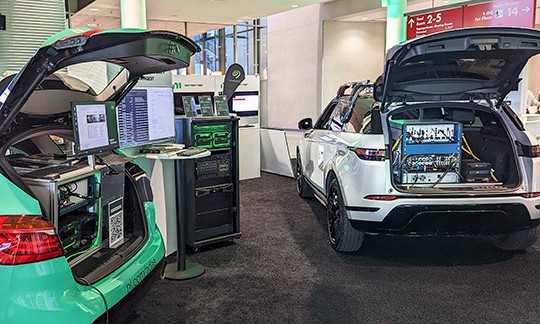
What is ADAS? Advanced Driver Assistance Basics
ADAS AND AD TESTING | 13 MINUTE READ
ADAS promises to enhance safety for motorists and pedestrians with features like collision avoidance and adaptive cruise control. Learn more in NI’s guide.
In recent years, the automotive industry has witnessed a remarkable transformation driven by technological advancements. One of the most significant developments in this domain is the emergence of Advanced Driver Assistance Systems (ADAS). These intelligent systems are revolutionizing the way vehicles operate, enhancing safety, and fundamentally changing the driving experience.
ADAS encompasses a suite of cutting-edge technologies designed to assist drivers. From collision avoidance and automatic parking to adaptive cruise control and lane departure warnings, ADAS systems work together to create a safer and more efficient driving environment.
Join us as we delve into the ever-evolving world of ADAS, exploring its underlying principles, functionalities, and features that make it a game-changer in automotive safety. We will also uncover how these advanced systems leverage sensor technology, onboard computers, and connectivity to supplement driver capabilities and usher in a new era of safer roads. This article will also address the testing challenges faced by engineers and the need to account for seemingly infinite scenarios that ADAS systems may encounter on the road.
By understanding the current state of ADAS, its potential for further advancements, and the importance of ADAS testing and validation, we can envision a future where road accidents become a thing of the past.
How ADAS Works
ADAS encompasses a range of innovative features that enhance vehicle safety and the driver experience. These features rely on a combination of sensors, like cameras, radars, LiDARs, ultrasonics and powerful onboard computers to perceive the surrounding environment, process data, and make informed decisions in real-time.
Sensors act as the eyes and ears of ADAS and therefore of the car itself, providing crucial data about the vehicle's surroundings. Radar sensors use radio waves to detect the position, speed, movement, and size of objects, helping ADAS systems identify potential collisions and enable Adaptive Cruise Control (ACC) function. Ultrasonic sensors emit sound waves to measure proximity to objects, aiding in parking assistance and obstacle detection. Additionally, cameras capture visual information, allowing for assisting functions like Lane Departure Warning (LDW), traffic sign recognition, and pedestrian detection.
However, the true power of ADAS lies in sensor fusion. Sensor fusion is the intelligent integration of data from multiple sensors by onboard computers called Electronic Control Units (ECUs) to form a comprehensive, accurate, and robust understanding of the environment. These computers are equipped with powerful processors running sophisticated algorithms that enable real-time analysis of sensor inputs. By leveraging machine learning and artificial intelligence techniques, ADAS systems can continuously learn from data, adapt to changing road conditions, and refine their responses. This fusion of sensor data enhances the system's ability to detect and interpret objects, anticipate potential hazards, and make well-informed decisions.
Embedded vision, another crucial aspect of ADAS, utilizes advanced image processing algorithms to extract meaningful information from camera inputs. By analyzing the visual data captured by cameras, embedded vision systems can identify lane markings, traffic signs, pedestrians, and other vehicles.
By harnessing the collective power of sensors, including cameras and onboard computers, ADAS systems gather comprehensive information about the environment and analyze it in real-time, allowing for enhanced perception and decision-making.
ADAS Features
Some of the most common Advanced Driver Assistance Systems in vehicles today include the following features:
Collision Avoidance
A Collision Avoidance System (CAS) actively works to prevent potential collisions. When sensors detect an object that might collide with the vehicle, the system sends warnings to the driver and automatically initiates braking to reduce speed and minimize the severity of the impact. In more advanced systems, collision avoidance technology also includes steering control. By taking control of the steering mechanism, the system can help steer the vehicle away from obstacles or into open spaces, further reducing the risk of a collision.
Collision avoidance systems rely on a combination of radar, lidar, and camera sensors to accurately identify and track objects, assess collision risks, and initiate appropriate actions. A crucial component of ADAS, collision avoidance systems enhance driver safety and have been proven effective in preventing accidents and reducing collision severity.
Lane Departure Warning
A Lane Departure Warning (LDW) system is another prominent feature in ADAS that aims to help drivers stay in their lanes and avoid unintentional lane drifts. The lane departure warning system uses image processing and pattern recognition algorithms to analyze the vehicle's position in relation to the lane markings.
Using cameras or other sensors, the system constantly monitors the road ahead and detects the lane boundaries. If the vehicle starts to drift without the driver activating the turn signal, the system triggers an alert, often through visual, audible, or haptic cues, to bring the driver's attention back to the road. A further evolution of this feature is Lane Keep Assist (LKA), which enables the function to actively steer the vehicle according to detected markings.
Adaptive Cruise Control
Adaptive Cruise Control (ACC) is a game-changing feature that utilizes sensors, such as radar or lidar, to monitor the distance and speed of vehicles in front, allowing for automated speed adjustments to maintain a preset gap.
By reducing the need for constant speed adjustments, ACC enhances driver comfort and reduces fatigue during long highway journeys while mitigating the risk of rear-end collisions by maintaining a safe distance from the vehicle ahead.
Blind Spot Monitoring
Blind Spot Monitoring (BSM) enhances driver awareness and safety during lane changes by expanding the driver’s perception of surrounding traffic. This technology uses sensors along the sides of the vehicle and intelligent algorithms to detect vehicles or objects in the driver's blind spots, providing timely alerts through visual indicators, auditory signals, or haptic feedback to prevent potential collisions.
Pedestrian Detection
Pedestrian Detection (PD) identifies people who are walking near the vehicle and helps prevent collisions. By analyzing data from cameras and sensors, pedestrian detection systems recognize pedestrian patterns and characteristics. When a person is detected, the system alerts the driver through visual and auditory signals, prompting them to act. Some advanced systems can apply automatic emergency braking if a collision is imminent.
Pedestrian detection technology continues to improve with machine learning and artificial intelligence, enhancing its accuracy in various conditions.
Driver Monitoring
A Driver Monitoring System (DMS) helps enhance safety by monitoring the driver's attentiveness and detecting signs of fatigue or distraction. This technology utilizes sensors, cameras, and advanced algorithms to assess the driver's behavior, ensuring they remain focused on the road. The system typically uses an infrared camera or sensors to capture the driver's facial features and monitor their eye movements, head position, and even changes in steering behavior. The advanced algorithms then process this data in real-time, comparing it to predefined patterns and alerting the driver if signs of fatigue or distraction are detected. This alert can be in the form of visual prompts, auditory signals, or haptic feedback, reminding the driver to refocus their attention on the road.
Traffic Sign Recognition
Traffic Sign Recognition (TSR) improves driver awareness and compliance with road regulations. This technology utilizes cameras and intelligent algorithms to detect and interpret traffic signs, providing drivers with real-time information about speed limits, stop signs, and other important signage.
After a traffic sign is recognized, the system relays the information to the driver through visual displays or head-up displays, ensuring that crucial traffic regulations are promptly communicated. This information helps drivers stay informed about speed limits, no-entry zones, overtaking restrictions, and other essential road signs, contributing to safer and more compliant driving behavior.
Automatic Parking
Automatic Parking Systems (APS) streamlines the parking experience by autonomously steering the vehicle into parking spaces. Using sensors, cameras, and intelligent algorithms, this technology identifies suitable parking spots and precisely guides the vehicle into position.
After a suitable spot is found, the automatic parking system takes control of the steering while the driver manages the brake and accelerator (this might also be covered by the automatic parking feature). The system calculates precise steering angles, coordinating with sensors to ensure accurate maneuvering. By simplifying parking maneuvers, it enhances convenience and confidence in tight or challenging parking situations.
Active versus Passive Systems
In the realm of ADAS, two main categories exist: active ADAS and passive ADAS. The key distinction lies in their respective roles and functions. Active ADAS refers to systems that actively intervene and assist in critical driving situations. These systems utilize sensors, cameras, and intelligent algorithms to detect potential hazards, issue warnings, and even perform automatic corrective actions. Examples of active ADAS include Collision Avoidance Systems (CAS), Lane Keep Assist (LKA) systems, and Automatic Emergency Braking (AEB).
On the other hand, passive ADAS focuses on providing information and alerts to the driver without directly intervening in the driving process. Passive ADAS systems use sensors and cameras to monitor the surrounding environment and provide feedback to the driver through visual or auditory alerts. Examples of passive ADAS include Blind Spot Monitoring (BSM) systems, rearview cameras, Lane Departure Warning (LDW) and Traffic Sign Recognition (TSR).
While active ADAS takes a proactive approach to enhance safety, passive ADAS serves as an additional layer of awareness and assistance, keeping the driver informed and aiding in decision-making. Together, these two categories of ADAS contribute to safer and more efficient driving experiences.
What’s the Difference Between ADAS and Autonomous Driving?
ADAS and Autonomous Driving (AD) are two distinct but interconnected concepts. ADAS refers to a set of advanced features and technologies designed to assist drivers in various aspects of driving. However, ADAS requires driver involvement and supervision, as the ultimate responsibility for driving lies with the human operator. On the other hand, Autonomous Driving, also known as self-driving or driverless technology, represents the pinnacle of automotive innovation. Autonomous vehicles can operate without human intervention, navigating roads and making decisions based on a combination of sensors, AI algorithms, and mapping data including positioning systems e. g. based on GNSS. Autonomous driving systems aim to replace the driver entirely, achieving higher levels of autonomy where the vehicle becomes fully self-sufficient.
While both concepts contribute to the evolution of automotive technology, autonomous driving holds the promise of reshaping the future of transportation as we know it. Autonomous vehicles are generally categorized into different levels based on their autonomy, ranging from no driver assistance to fully autonomous operation in specific conditions. These levels offer a progressive view of the path toward a driverless future.
Six Levels of Driving Automation
Level 0: No Automation
The driver has complete control and responsibility for all aspects of driving. No automated features are present.
Level 1: Driver Assistance
Basic automation features are introduced, such as adaptive cruise control or lane-keeping assistance. However, the driver remains fully in control and must actively monitor the driving environment.
Level 2: Partial Automation
The vehicle can simultaneously control two or more functions, such as steering and acceleration/deceleration, under specific conditions. The driver is still required to supervise and intervene if necessary.
Level 3: Conditional Automation
The vehicle can manage most driving tasks under certain conditions, but the driver must be prepared to take over when alerted by the system within a specific timeframe. The driver can disengage from actively monitoring the environment in limited scenarios.
Level 4: High Automation
The vehicle can perform most driving tasks without driver intervention in specific driving conditions and environments. However, the driver may still take control if desired or required (specific driving conditions are not met).
Level 5: Full Automation
The vehicle is fully autonomous and can perform all driving tasks without any human intervention in all driving conditions. A human driver is not needed, and occupants can be passengers.
These definitions make it possible to provide a simplified view on the boundaries of ADAS vs. Autonomous Driving. Levels 0 to 2 can be mapped to ADAS, while Autonomous Driving typically refers to and starts at level 3 and above.
ADAS and the Future of Safer Transportation
ADAS plays a pivotal role in ensuring safer driving by leveraging advanced technologies to enhance driver awareness, assist in critical situations, and mitigate the risk of accidents. The goals of this ecosystem of features working together also perfectly align with the goals of Vision Zero, which aims to eliminate traffic fatalities and injuries while increasing safety for drivers and vulnerable road users alike. However, it's important to note that ADAS should always be used in conjunction with responsible and attentive driving practices, as driver engagement remains crucial in ensuring safe and responsible vehicle operation.
NI’s Role in Testing Advanced Driver Assistance Systems
Ensuring the reliability and effectiveness of ADAS features requires rigorous testing and validation. ADAS testing provides a comprehensive evaluation of the system's functionality, accuracy, and robustness.
ADAS testing involves simulating real-world scenarios to assess the system's response and performance in various driving conditions. It encompasses a range of tests, including sensor calibration, object detection and recognition, collision avoidance, lane keeping, and adaptive cruise control assessments. Through rigorous testing, ADAS systems can be fine-tuned, verified, and validated before deployment, ensuring their reliability and effectiveness in a seemingly infinite amount of real-world driving scenarios.
NI offers cutting-edge hardware and software solutions that can be applied to ADAS development and testing, enabling automotive engineers to overcome the challenges of validating and optimizing ADAS functionalities.
Our open and adaptable toolchain allows seamless integration of testing technologies, simulation tools, cloud computing, and IT infrastructure, creating a connected ecosystem for efficient testing. NI's industry-standard hardware, such as PXI systems, provides modular and flexible instrumentation-grade I/O, ensuring precise measurement quality and synchronization for cutting-edge testing.
Further, NI's open software-centric approach facilitates integration with third-party simulation tool providers and cloud services, enabling engineers to choose the best solutions for their specific needs. With NI's ADAS and AD ecosystem, engineers can collaborate with subject matter experts and leverage technologies like data record, data replay, digital twins, hardware-in-the-loop (HIL), sensor fusion, and other verification and validation (V&V) applications.
Using NI's hardware and software solutions, automotive companies can accelerate their ADAS and AD development, increase test coverage, and maintain non-negotiable performance. The connected workflow offered by NI ensures a streamlined testing process, ultimately getting vehicles to market faster and with enhanced safety, meeting the ever-evolving demands of the active safety domain.


